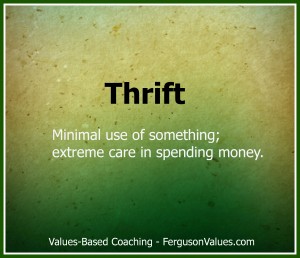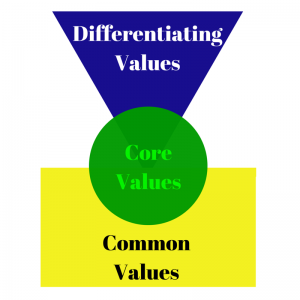The Value of Thrift in Marketing
The value of thrift means minimal use of something; extreme care in spending money.
Marketing Questions:
- When is the last time you brought a group of creative minds together to discuss how to market your brand better, with fewer resources?
- Other than money, what resources and relationships do you possess that can be leveraged to connect with your target audience?
- What businesses or organizations are also targeting your customer groups? How can you work together to create a win-win?
- How can you leverage every dollar spent on marketing to do double duty: create awareness and make existing customers feel good about your brand?
- Think of a business you know of that is extremely careful in how they spend money on marketing and yet are building a successful business. What are they doing that’s different?
- If your marketing budget was slashed to (or is) $0, what are some creative ways to promote your brand?
Thriving on Thrift
A decade ago Sprint PCS, the cellular/wireless division of Sprint, was one of my marketing clients (prior to the merger with Nextel). The company started in 1995 and within 5 years reached $5 Billion in revenue. At the time, Sprint PCS claimed to have reached this milestone faster than any other business start-up.
To achieve this growth, Sprint PCS was spending hundreds of millions of dollars on advertising. Their parent company (Sprint) had deep pockets. Most of this spend was TV, radio, print, and outdoor boards. Combined with their major rivals (at the time) – AT&T, Verizon, and Cingular – the total advertising spend was in the multiples of billions of dollars.
In other words, these cellular providers were “spending” their way to success. Sometimes it felt like a race to see who could spend more….
Yet, over the past 20 years, many start-ups have built successful businesses on little-to-no ad spending – initially.
Some embraced guerilla-marketing tactics. For example, something you buy (or do) without thinking today was once a first time purchase. Maybe it’s a personal hygiene product or an app on your smartphone. Or maybe it’s an online service you use to store notes or important files. Remember when you first heard the name of that company or product, maybe from a friend – or even a stranger? Consider what had to happen for that company’s name to be brought up or referenced. Then when you heard or read the brand name 3, 4 or 7 times, think about the buzz that had to be created to make that happen.
Other companies chose to invest their energies and resources into making a world-class product – or customer experience – that became the magnet that drew customers. That was an initial strategy of Amazon.com. And it worked very well. Other marketers would say to me “we want our website to provide 1-click solutions they way Amazon does it.” Amazon created the standard for a best-in-class on-line buying experience. And the results show it.
Of course, once momentum has been created and significant ongoing profits are being generated, then marketers generally join the ranks of ‘big spenders’ and show the world they too can play in the big leagues. That’s why such successful brands as Amazon and Google are now amongst the top ad spenders.
But hopefully they don’t forget their roots. It started with thriving on thrift.
How can the value of thrift help you create competitive advantage?
Today’s value was selected from the “Pragmatism-Prudence” category, based on the e-book Developing Your Differentiating Values.








